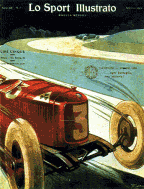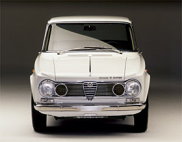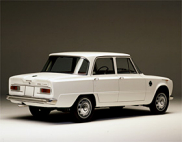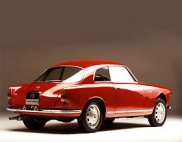
.
. .
..
. . .
Related Topics: ©
1999-2003 Copyright |
Alfa Romeo : Alfa gets 90
Alfa Romeo's ninety years of existence encompass some of the most important chapters in motoring history. It is a story of cars, designers, races and engines that stand as technological and sporting milestones of the Twentieth century. A brand such as Alfa Romeo is the sum of all these parts, and also of the work and professional pride of the thousands of people - engineers, workers and managers - who have succeeded one another in its factories and offices and on the racing track.
A brief look at the origins and history of Anonima Lombarda Fabbrica Automobili, year of foundation 1910, allows us to understand how a legendary motoring tradition came into being. Alfa cars were originally built for racing and for years the public was offered cars built to exactly the same specifications. Then as now, the cars were built to be good looking and full of character. They displayed a magical balance between reason and sentiment, engineering and creativity.
Alfa Romeo does not see tradition as a set of engineering traits and motifs that can be locked away in a dusty album. The company sees it as a living heritage that can be critically reviewed and reinterpreted whenever a new model is created. The only thing that has not changed throughout these 90 years is the Brand's creative vitality and its way of understanding cars. Alfa Romeos are still not made for people who believe driving is boring and see cars only as a means of getting from A to B. They are built to transcend the essential and enter the realm of emotion. They embody aesthetic taste, a passion for sophisticated engineering, the pleasure of sitting behind a driving wheel and the desire to express one's own personality. This is one of the secrets behind the vitality of a Brand that has recently enjoyed a great revival and can now rely on the appreciation of many customers throughout the world. The act of celebrating Alfa Romeo's 90th birthday and reviewing its history is thus a journey to the root of a legend. This journey will help us understand how that inimitable personality came into being and explain why you can immediately tell the difference between a car wearing the Alfa Romeo shield and any other car on the road today.
CELEBRATIONS To relive the story of an extraordinary legend. This is the opportunity offered to car enthusiasts and, of course, to the public at large, by the programme of events arranged to celebrate Alfa's 90th anniversary. For a start there's the exhibition Cuore Sportivo. The Essence of Beauty. After its success in Dublin - more than 30 thousand visitors, including Michael Schumacher who flew in on his way back from victory in the Formula 1 Grand Prix in Brazil - in the autumn the exhibition will travel to Warsaw and then Vienna. Highlight of the exhibition is a collection of 24 models that are part of motoring history which will leave the new museum at Arese to once again delight car enthusiasts - both young and old. From the 6C 1750 GS (the model with which Nuvolari and Varzi battled it out in the 1930 Mille Miglia) to the 159 Grand Prix car in which Juan Manuel Fangio won the World Championship in 1951. Or the imposing Touring-styled 8C 2900 B Lungo from 1938 to the 6C 2500 Super Sport Villa d'Este, winner of the Villa d'Este Concours d'Elegance in 1949. And then again, the 1900 Super Sprint from 1954, the Giulietta two-seater designed by Pininfarina (1955), the Proteo concept car dating from 1991 and the Nuvola prototype created in 1996. Right up to the latest addition to the family, the Sportwagon. And alongside the cars - engines, drawings, renderings, posters, sketches of designers and technicians, photos of these racing cars in action on the circuit. All of which confirms that cutting-edge technology and creative design have always been household words at Alfa Romeo - a part of everyday activity. Alfa Romeo will also participate in the annual Festival of Speed scheduled for June 23 to 26 at Goodwood House, the home of Lord March, near to what was one of the shrines of British motor sport up until the end of the '60s. Right from the first edition in 1993 this event has not only been a must for racing fans and collectors but also for today's drivers and team managers. The theme of the next meeting is 50 years of the Formula 1 Championship that happens to coincide with Alfa Romeo's 90th anniversary. As many will remember Alfa Romeo won the first edition of the Formula 1 Championship in 1950 with the Alfetta 158 and this year the Company will be participating with a number of its car production 'masterpieces' from the Historical Museum. These will be: the Grand Prix Tipo B or P3 from 1932 which was linked to Tazio Nuvolari's many great victories, the 159 (with which Fangio won the World Championship in 1951), the 2900 Le Mans prototype (created for the world's most famous 24-hour race in 1938) and the 33 TT 12 that won the World Constructors Championship in 1975. Instead, on show only will be the 1900 Super Sprint (1954) Touring version, the two-seater Giulietta from 1955 designed by Pininfarina, the Giulietta SZ (1958) and the 6C 2500 Super Sprint (1947), the first Alfa produced in the postwar years which will also participate in the 'Concours d'Elegance' which is again part of the British event. And then the brand will sponsor two important sporting events that will see the participation of the Portello Team and the RIAR (Italian Alfa Romeo Register). Concerning the former, the Team will be the only Italian entry alongside 94 foreign teams in the 2000 London-Sydney Marathon for cars built before 1970. This 18-thousand kilometre event will get underway on June 2 in London and cars will cross central Europe and on through Rumania, Turkey and Iran. The arrival in Sydney is planned for July 2, the day of the official opening ceremony of the Olympics. The car chosen to compete is a 1967 Giulia Ti Super that will be driven by Marco Cajani, the Team's president and winner of the European Championship for vintage cars - Touring category - in 1987, 1991 and 1995. A further Alfa Romeo contribution to this International Marathon - which the Company intends to style as a real 'Alfa event' - will be a 156 Sportwagon that will act as the support car and, of course, the involvement of subsidiaries in the countries touched by the Marathon. Instead, from September 1 to 9 the RIAR will organise an event linked to the Company's sporting history: the XXI International Rally for Alfa Romeo Vintage Cars - Sicily and the Targa Florio. An event that has also been honoured by the patronage of the President of the Republic and the Region of Sicily. It will be a really spectacular appointment: 50 Alfa Romeo cars built before 1965 will drive in procession over the island's well-known tourist and sporting itineraries. After a visit to the city of Palermo's most attractive landmarks, the teams will drive on to Noto, Syracuse, Catania, Caltanisetta, Ragusa, Trabia and then to the superb 'Madonie Circuit' where in 1930 Alfa Romeo won the Targa Florio with Achille Varzi at the wheel of a P2. Then on again to Cefalý, Acireale, Erice, Segesta and back to Palermo to be welcomed by the Mayor, followed by the prize awards. Apart from the official events mentioned above, many more have been planned by other clubs and enthusiasts.
|
.
.
|












